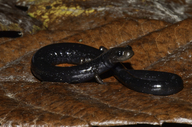|
Oedipina capitalina Solis, Espinal, Valle, O'Reilly, Itgen & Townsend, 2016
Cerro Grande worm Salamander Subgenus: Oedipina | family: Plethodontidae subfamily: Hemidactyliinae genus: Oedipina |
| Species Description: Solis JM, Espinal MR, Valle RE, O'Reilly CM, Itgen MW, Townsend JH 2016 On the taxonomy of Oedpina stuarti (Caudata: Plethodotidae), with description of a new species from suburban Tegucigalpa, Honduras. Salamandra 42: 125-133. | |
 © 2016 Michael W. Itgen (1 of 1) |
|
|
|
Description Oedipina capitalina is most easily distinguishable from other Oedipina and similar salamanders by the number of its costal grooves, the number of maxillary teeth, and the number of vomerine teeth. Oedipina capitalina has 19 costal grooves, while O. elongata, O. gephyra, and O. tomasi all bear 18 costal grooves; O. petiole has 17, O. motaguae has 21, O. salvadorensis has 21 – 22, and O. tzutujilorum has 20. Oedipina nica has 19 - 20 costal grooves, but can be distinguished from O. capitalina by the number of teeth. Oedipina capitalina has 27 - 38 maxillary teeth while O. nica has between 41 - 48 maxillary teeth, O. koehleri has 36 – 44, O. motaguae has 13 – 19, O. salvadorensis has 13, and O. stuarti has 43 – 45 maxillary teeth. Maxillary teeth number also separates O. capitalina from all members of the Oedopinola subgenus. As for vomerine teeth, O. capitalina appears to have a relatively large number (20 – 24) in comparison to other Oedipina species, with O. ignea having 12 - 21, O. kasios having 10 - 15, O. leptopoda having 10 – 17, O. motaguae having 9 – 18, O. nica and O. stenopodia having 9 - 18, O. petiole having 10, O. stuarti having 17 – 19, O. taylori having 8, and O. tzutujilorum having 8 – 13. Oedipina capitalina can be more specifically differentiated from, O. stuarti by the former lacking glands that extend from the head to the tail and having dark pigmentation on the lower portion of the limbs (Solís et al. 2016). In life, Oedipina capitalina has a hazel head and limbs and a darker greyish brown body and tail Tiny fleck-like white and blue iridophores cover the salamander on all surfaces, but are especially prominent on the dorsal surfaces of the head, body, and tail (Solís et al. 2016). The five specimens of O. capitalina are all similar in coloration and body shape. However there was variation in the number of maxillary teeth (27 - 38 teeth), and number of vomerine teeth (20 - 24 teeth) (Solís et al. 2016). Distribution and Habitat Country distribution from AmphibiaWeb's database: Honduras
Life History, Abundance, Activity, and Special Behaviors Trends and Threats Possible reasons for amphibian decline General habitat alteration and loss Comments A limited genetic analysis supports preliminarily placing O. capitalina in a clade along with O. ignea, O. taylori, and O. stenopodia. Within this clade, O. capitalina, O. ignea, and O. stenopodia form a polytomy. This information was obtained by Bayesian and Maximum Likelihood analysis using 16S large subunit RNA and cytochrome b (Solís et al. 2016). The specific name “capitalina” was chosen in reference to the closeness of O. capitalina’s type locality to the Honduran capital, Tegucigalpa. The word “capitalina” is a local colloquialism referring to female residents of the capital city (Solís et al. 2016). Though the specific name “capitalina” is a Honduran term for female residents of the capital, the holotype for this species is male (Solís et al. 2016).
References
Solís, J., Espinal, M., Valle, R., O’Reilly, C., Itgen, M., Townsend, J. (2016). ''On the taxonomy of Oedipina stuarti (Caudata: Plethodontidae), with description of a new species from suburban Tegucigalpa, Honduras.'' Salamandra, 52(2), 125-133. [link] Originally submitted by: Robert Perrot (first posted 2018-12-12) Edited by: Ann T. Chang (2018-12-12) Species Account Citation: AmphibiaWeb 2018 Oedipina capitalina: Cerro Grande worm Salamander <https://amphibiaweb.org/species/8485> University of California, Berkeley, CA, USA. Accessed Apr 25, 2024.
Feedback or comments about this page.
Citation: AmphibiaWeb. 2024. <https://amphibiaweb.org> University of California, Berkeley, CA, USA. Accessed 25 Apr 2024. AmphibiaWeb's policy on data use. |



 Raffaëlli Account
Raffaëlli Account Map of Life
Map of Life